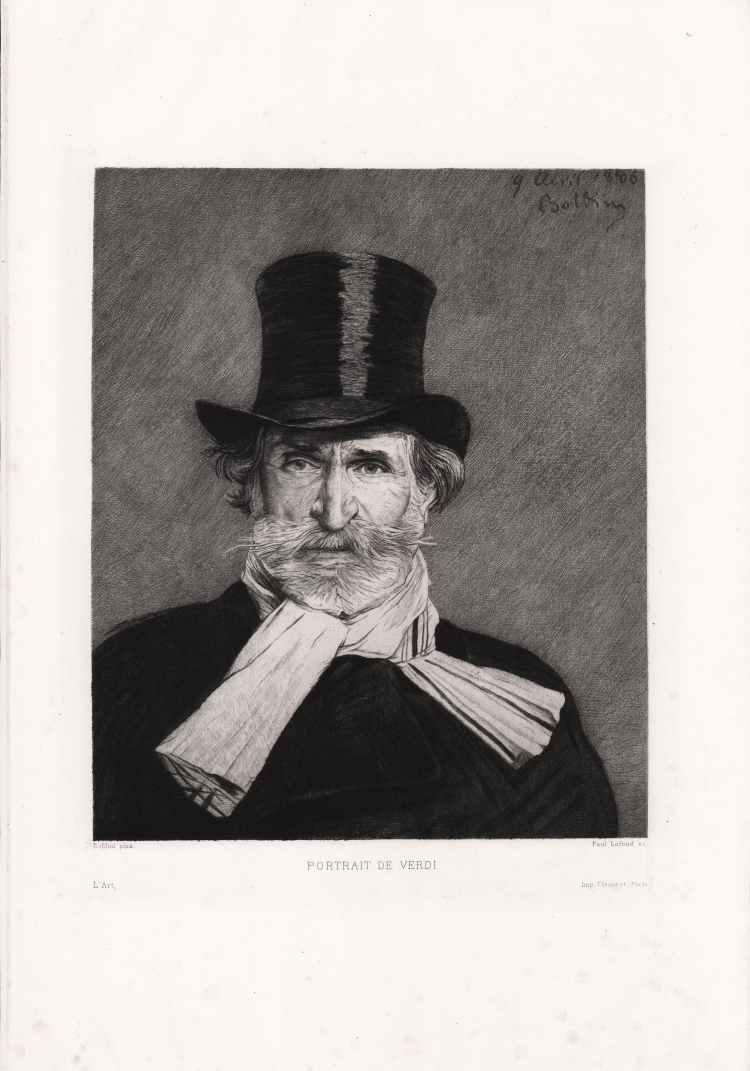




| Reference: | S46036 |
| Author | Paul-Jean-Marie LAFOND |
| Year: | 1889 |
| Measures: | 250 x 300 mm |



| Reference: | S46036 |
| Author | Paul-Jean-Marie LAFOND |
| Year: | 1889 |
| Measures: | 250 x 300 mm |
Etching, 1889, signed in plate at bottom.
From a pastel by Giovanni Boldini, etched by Paul Lafond under the direction of Boldini himself.
The portrait of Giuseppe Verdi (1813 - 1901) was executed by Giovanni Boldini (Ferrara 1842/Paris 1931) on April 9, 1886, as attested by the autograph inscription at upper right. Boldini met Verdi for the first time on Christmas Day 1884, spent in Genoa at the home of the Maestro and his wife, Giuseppina Strepponi: acting as a go-between was Emanuele Muzio, Verdi's pupil and right-hand man, whom Boldini met around 1882 at the Parisian club "Mère Morel." Muzio had been involved in the staging and administration of Verdi's operas abroad since the mid-1860s; in 1870 he became director of the Italian Opera in Paris. This pastel portrait was preceded by an oil painting, currently preserved in Milan at the Giuseppe Verdi Foundation Rest Home for Musicians.
The publishing house Ricordi, because of the great success that the opera had aroused, commissioned the specialist Paul Lafond this etching, executed under the direction of Boldini himself, finished in 1889.
Beautiful impression, on contemporary laid paper, with full margins, very good condition.
Paul-Jean-Marie LAFOND (1847-1918)
|
Jean Marie Paul Lafond (July 1, 1847 in Rouen; † September 21, 1918 in Pau) was a French art historian, draughtsman and engraver. His father Jean-Marie Lafond, a merchant, traded in Beaujolais wine. Nothing is known about the education of his son Paul Lafond. From 1900 he was curator of the municipal art museum in Pau and became known as an art historian with publications on Goya (1902), Murillo (1908), Rogier van der Weyden (1912), El Greco (1913), Hieronymus Bosch (1914), and Edgar Degas (1918/19). His second profession, that of engraver, came in handy in designing these art books. Lafond had learned the use of these graphic processes in Louis Capdevielle's atelier. He had initially made engravings from drawings by Camille Corot, Charles-François Daubigny, Charles Jacque, and Alfred Elias, and then made a name for himself with works of his own at the Salon of the Société nationale des beaux-arts. He was a friend of Edgar Degas, who frequently visited Pau. Under the signature P. Lafond, he wrote numerous entries-primarily on Spanish painters and sculptors, but also on decorative art-for volumes 1 to 5 of the General Encyclopedia of Fine Arts from Antiquity to the Present. Paul Lafond served on Pau's city council from 1900 until his death. A square and the media center in Pau were named after him.
|
Paul-Jean-Marie LAFOND (1847-1918)
|
Jean Marie Paul Lafond (July 1, 1847 in Rouen; † September 21, 1918 in Pau) was a French art historian, draughtsman and engraver. His father Jean-Marie Lafond, a merchant, traded in Beaujolais wine. Nothing is known about the education of his son Paul Lafond. From 1900 he was curator of the municipal art museum in Pau and became known as an art historian with publications on Goya (1902), Murillo (1908), Rogier van der Weyden (1912), El Greco (1913), Hieronymus Bosch (1914), and Edgar Degas (1918/19). His second profession, that of engraver, came in handy in designing these art books. Lafond had learned the use of these graphic processes in Louis Capdevielle's atelier. He had initially made engravings from drawings by Camille Corot, Charles-François Daubigny, Charles Jacque, and Alfred Elias, and then made a name for himself with works of his own at the Salon of the Société nationale des beaux-arts. He was a friend of Edgar Degas, who frequently visited Pau. Under the signature P. Lafond, he wrote numerous entries-primarily on Spanish painters and sculptors, but also on decorative art-for volumes 1 to 5 of the General Encyclopedia of Fine Arts from Antiquity to the Present. Paul Lafond served on Pau's city council from 1900 until his death. A square and the media center in Pau were named after him.
|